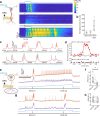This is a preprint.
Dendritic excitations govern back-propagation via a spike-rate accelerometer
- PMID: 37398232
- PMCID: PMC10312650
- DOI: 10.1101/2023.06.02.543490
Dendritic excitations govern back-propagation via a spike-rate accelerometer
Update in
-
Dendritic excitations govern back-propagation via a spike-rate accelerometer.Nat Commun. 2025 Feb 4;16(1):1333. doi: 10.1038/s41467-025-55819-9. Nat Commun. 2025. PMID: 39905023 Free PMC article.
Abstract
Dendrites on neurons support nonlinear electrical excitations, but the computational significance of these events is not well understood. We developed molecular, optical, and analytical tools to map sub-millisecond voltage dynamics throughout the dendritic trees of CA1 pyramidal neurons under diverse optogenetic and synaptic stimulus patterns, in acute brain slices. We observed history-dependent spike back-propagation in distal dendrites, driven by locally generated Na+ spikes (dSpikes). Dendritic depolarization created a transient window for dSpike propagation, opened by A-type channel inactivation, and closed by slow inactivation. Collisions of dSpikes with synaptic inputs triggered calcium channel and N-methyl-D-aspartate receptor (NMDAR)-dependent plateau potentials, with accompanying complex spikes at the soma. This hierarchical ion channel network acts as a spike-rate accelerometer, providing an intuitive picture of how dendritic excitations shape associative plasticity rules.
Keywords: all-optical electrophysiology; dendritic biophysics; dendritic spikes; plateau potentials; spike back-propagation.
Conflict of interest statement
Competing interests The authors declare no competing interests.
Figures






References
-
- Stuart G. J. & Sakmann B. Active propagation of somatic action potentials into neocortical pyramidal cell dendrites. Nature 367, 69–72 (1994). - PubMed
-
- Markram H., Lübke J., Frotscher M. & Sakmann B. Regulation of synaptic efficacy by coincidence of postsynaptic APs and EPSPs. Science 275, 213–215 (1997). - PubMed
-
- Stuart G. J. & Spruston N. Dendritic integration: 60 years of progress. Nat. Neurosci. 18, 1713–1721 (2015). - PubMed
-
- Magee J. C. Dendritic integration of excitatory synaptic input. Nat. Rev. Neurosci. 1, 181–190 (2000). - PubMed
Publication types
Grants and funding
LinkOut - more resources
Full Text Sources
Research Materials
Miscellaneous
